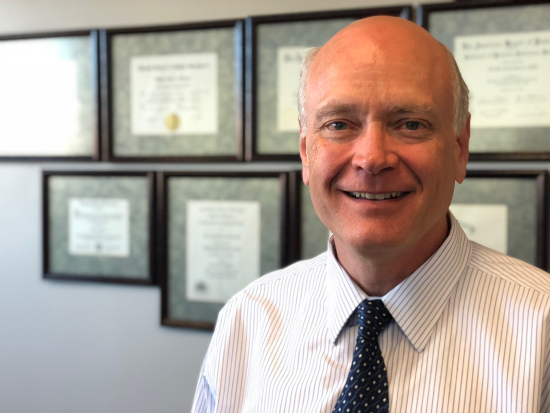
When he discusses his first day on the job at WMed in 2011, Dr. Hal B. Jenson chuckles when he thinks about what existed at that time – himself, his administrative assistant, and the $100 million gift that was the foundational funding for the medical school.
A building – a physical home – for WMed didn’t exist yet. The school was more than three years away from accepting the students who would make up its inaugural MD class.
To say things have changed – that much has been accomplished since then – would be an understatement.
“It has been as much work as I thought it would be,” Dr. Jenson said. “It’s been as fun as I would have hoped, and we’ve been as successful as I could have possibly imagined.”
Having been at the medical school from the beginning, Dr. Jenson can quickly and easily tick off the accomplishments of which he is proudest.
- The W.E. Upjohn M.D. Campus, which opened in 2014, is home to the medical school’s MD and master’s degree students; a Simulation Center that serves as a hub of activity and training for students, residents, fellows, faculty and multiple other medical professionals in southwest Michigan; and biomedical science research laboratories.
- The development and implementation of the MD curriculum, as well as the selection and admissions process at WMed. Earlier this year, the medical school was granted full accreditation for five years from the Liaison Committee on Medical Education (LCME).
- The launch of three master’s degree programs in Biomedical Sciences, Clinical Informatics, and Medical Engineering.
- The total number of employed faculty and staff, and residents and fellows at the medical school since Kalamazoo Center for Medical Studies merged into WMed has grown significantly from 483 in 2012 to 820 today. In addition, WMed has appointed more than 600 community faculty.
- The creation of the centers for Clinical Research and Immunobiology at WMed, and the acquisition in 2016 of the Innovation Center.
- The formation of the medical school’s Department of Pathology, which today includes six faculty who also work as forensic pathologists, serving as medical examiners for 11 counties in Michigan.
- The establishment of new residency programs in Obstetrics and Gynecology, and Family Medicine in Battle Creek as well as a new Simulation Fellowship.
- Creation of the Early Introduction to Health Careers pipeline programs for elementary and high school students at Kalamazoo Public Schools. The initiative has also expanded regionally into Battle Creek, where a program has been piloted for eighth-grade students at Lakeview School District with the intention of expanding in the next year. These programs are designed to foster biomedical science and health career aspirations for underrepresented and disadvantaged youth in southwest Michigan and provide science education and enrichment as part of the goal to increase diversity among youth who pursue health careers.
- Engagement with the Battle Creek VA Medical Center, which now serves as a training site for residents in the medical school’s Internal Medicine and Psychiatry residency programs.
- Involvement in Cradle Kalamazoo, a community-based initiative aimed at reducing the infant mortality rate in Kalamazoo County and the glaring racial disparities that exist.
- Achieving accreditation with LCME and the Higher Learning Commission, and certification with the U.S. Department of Education “as quickly as could have been hoped for.”
- The graduation in May of the 48 students in the medical school’s inaugural Class of 2018, and a successful Match Day in March that saw every student in the inaugural class match with a residency program.
“With our first graduation, and having completed an entire cycle, 2018 was also the graduation of the medical school,” Dr. Jenson said. “We’re no longer a new medical school.”
And even as he looks back and takes a moment to celebrate all that has taken place, all that has been accomplished during the last seven years, Dr. Jenson is also looking to the future and the challenges he says the institution and its stakeholders will face.
“We still have much work to do,” he said. “Healthcare is changing, and education continues to change. We are working on doing things even better than we have in the past and focusing on operational excellence. A big challenge is how medicine is practiced, and we have to change how we practice medicine in our clinics because of changes in healthcare financing, the heightened focus on quality of care, and the greater role of interprofessional practice. We need to train our residents to be ready to seamlessly transition to contemporary practices when they graduate.”
As he looks forward to the future and the maturation of WMed, he said the institution will face the challenges that other legacy medical schools take on in building a high-performing academic medical center with a strong culture of collaboration and academic pursuits.
“We have to continue to be innovative in our curriculum. That should never stop,” Dr. Jenson said. “Every year, we have to recruit new students, new residents, and new faculty, and that never stops. We have to integrate education and research into everything that we do. Building a culture of excellence, collaboration, and discovery is our priority challenge.”

